A Primer for Born-Again Cyclists
Getting Started:
A Primer for Born-Again Cyclists
If it’s been years since you were last on a bike, you may have to adopt a step-by-step approach to build up your capacity to do some serious cycling on a regular basis. Fortunately, this can happen quite quickly, and you will soon be riding surprisingly long distances without giving it a second thought. The following are some pointers for getting back in the saddle.
Setting objectives for yourself
If you want to start doing some serious cycling, set certain objectives for yourself. Rather than ride around aimlessly, you should decide on one or more routes that incorporate quiet roads in your neighbourhood and maybe some nearby bicycle paths.

Get out on your bike regularly and you’ll soon be riding longer distances with ease.
When figuring out specific routes, you will have to decide how much distance you’ll want to cover with first couple of rides. Depending on your age, level of fitness, and overall cycling skills, this could be anywhere from 4 or 5 kilometres to as much as 20 or more. Whatever the case, pick a distance that is a bit challenging, but still realistic.
You should also consider the direction of the wind when going out for longer rides. You may want to start off the first portion of the ride by heading into the wind – that way you’ll have the wind at your back for the return leg when you might be running a little low on energy.
Go out cycling on a regular basis
The next step is the most important – go out and cycle your routes on a regular basis. How often will vary from person to person, but cycling twice a week is not too much. For most people, going out three or more times a week would be better. However, if you haven’t been physically active in a while, make sure you schedule a rest day or two between rides to allow your sore muscles (and maybe a soar posterior) time to recover.
At first, you may end up cycling your routes slowly and making a number of rest stops. If you get tired, there is absolutely nothing wrong with finding a nice park bench to enjoy the scenery or to sit back and simply watch the comings-and-goings on one of the paths. It is also a good idea to take advantage of any rest stops to do some stretching exercises to keep your muscles from tightening up.
Increasing your rides in stages
You’ll want to continue cycling your initial routes on a regular basis until you can complete it without much difficulty. Again, this will vary from person to person, but it could take anywhere from one week to two or three weeks. Once you have reached this point, it will be time to extend your routes (maybe by 30% to 50%) and repeating the whole process. You keep extending the length of your routes until you are able to comfortably ride the distance necessary for the type of cycling you plan to do.
How far should you go in extending your distances? It’s really up to you, but it is nice to reach the plateau where you are able to ride 50 kilometres without any great difficulty. This is a distance that will let you see much of what the city has to offer or to escape Ottawa/Gatineau’s urban boundary. It’s also a distance that will allow you to participate in some of the groups rides organized by local bike clubs or to sign up for various multi-day bicycle tours that are offered by commercial outfitters. If you feel up to it, there’s no reason to stop at the 50 kilometre plateau. Some cyclists think nothing of going out for a 100, or even a 200 kilometre ride.
A little hardship and then triumph & jubilance
Although it may all sound easy when reading about it, you are bound to encounter a few discouraging days as you work through your cycling regimen. After the first few outings, you may jump to the conclusion that a 50 kilometre ride is a pie-in-the-sky objective that is fine for “real cyclists”, but is simply not applicable for someone like you. This is not true if you are reasonably healthy and able-bodied.
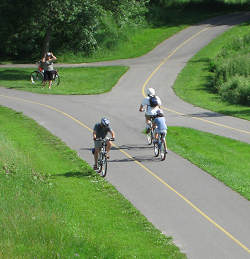
The network of paths in the Ottawa-Gatineau area is a perfect place to get back into cycling.
As you persevere, there will likely be days when you will be 15 or more kilometres from your residence, getting a little tired, and cursing the fact that you only have a bicycle to get yourself home. At times like this you may question how you got yourself into such a situation. However, this mindset will disappear as you complete longer and longer rides. In fact, you will soon find yourself quietly laughing at what you once thought were insurmountable long distances.
The moment of revelation will come when you realize that you just completed a 40 or 50 kilometre ride, noticed that it wasn’t all that difficult, that you aren’t very tired, and that you are actually ready for more. It will then occur to you that you have now joined the ranks of the so-called “real cyclists”. You’ll be able to bike all around town, participate in groups rides, do some cyclotouring, and even join a bicycle club without fear or trepidation. Life will now become very simple: eat, sleep, and ride your bike.
Forgot how to ride a bicycle?
Not a problem. Even if it has been decades since you last went cycling, you never really forget how to ride a bike. In fact scientists often focus on bicycling when studying how the human brain retains old memories for certain motor skills. However, you’ll probably be very wobbly when you first get back on a bike, so you may want to take a few extra precautions.
It may be a good idea to find an empty parking lot at a nearby school or church to practice some rudimentary cycling skills. You may want to temporarily lower the bicycle seat so your feet will make easy contact with the ground. When seated on the bike, try using your feet on the ground to push yourself forward. Once you are scooting along and starting to regain your sense of balance on a bicycle, try using the pedals to maintain your forward momentum. Keep at it as you practice your starts, stops, and turns.
Depending on how quickly your confidence returns, you may need to schedule two or three of these practice sessions before you are ready to embark on the cycling regimen described at the beginning of this article. Moreover, once you get the hang of riding the bike, don’t forget to raise the seat to its proper height. Riding with too-low a seat is inefficient and can lead to knee injuries.
If after all this, you’re still looking for ways to improve your cycling skills, remember that the City of Ottawa offers bicycle courses aimed specifically at adults. This includes the Can-Bike 1 and Can-Bike II programs, Cycling Skills for Women, and Cycling Skills for Seniors.
Good “bike fit”
Good “bike fit” is very important for anyone who cycles longer distances on a regular basis. You should have a reasonably good quality bike that is generally the right size for you. Although it depends on the type of bike and its frame geometry, the general rule of thumb is that there should be about 1 to 2 inches (2.5 to 5 cm) clearance between the top tube and your crotch when standing over the bike.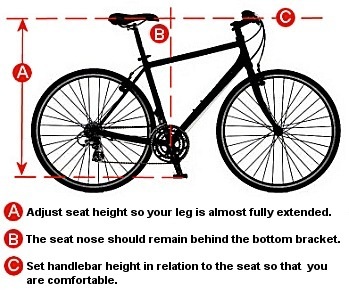
Many beginners often set their seats (saddles) way too low. It should be high enough so that your leg is almost fully extended when seated and the pedal is at the lowest point on its downward stroke (there should be a slight bend in leg). However, the seat shouldn’t be so high that you will rock your hips from side to side when pedaling (this is easy to verify by someone riding directly behind you).
The seat should be more or less parallel to the ground. The fore-aft position of the seat can also be adjusted. You may want to move it forward just a little to help you reach the handle bars more comfortably, but in most cases the nose of the seat should remain well behind the bike’s bottom bracket (the point where the pedal arms are attached to the axle).
Unless you are going for maximum performance, you’ll probably want to raise the handle bars so that they are at the same height as the seat. Some people insist on setting the handle bars even higher so that they ride in a totally up right sitting position. There’s nothing terribly wrong with this, but biking is more efficient when there is some forward lean in cyclist’s upper body (the exact amount should be determined by what you are comfortable with). Whatever the case, avoid the opposite situation where the handle bars are so low that you have to use your arms to support your upper body when leaning forward.
Note that the above should only be taken as a “starting point” for making adjustments which will provide a “bike fit” that is suitable for you. There is alway room for some variation in a bike’s setup to accommodate different riding styles and physiques. On the other hand, if there’s a drastic difference between what is suggested and your bike’s set up, there is probably something wrong. For more on this subject, see “Good Bike Fit for Comfortable and Pain-free Cycling“.
What to bring & bicycle accessories
You should get in the habit of automatically bringing essential and near-essential items everytime you go out riding. This includes a small portable air pump, a patch repair kit, tire levers, and an extra inner tube (it is much easier to change a tube than to patch a difficult-to-find leak). It is also a good idea to carry one of those small bicycle multi-tools which includes folding hex keys and a screw driver.
Riding with a helmet makes a lot of sense, although it is not a legal requirement for adults. A good U-lock will come in handy for times when you want to stop and leave your bike for while. You should be ready to cycle after dark by carrying front and rear LED lights. Such lights are compact, easy to store, and use surprisingly little battery power. In Ontario your bike needs to be equipped with a bell or you could be hit with a hefty fine ($85). Check out the mini-bells sold at most bike shops.
For yourself, make sure your bike is equipped with at least one water bottle and holder (two when cycling longer distances on hot days). If you are out cycling for more than 1.5 to 2 hours, you should also bring a couple of granola bars or other high carbohydrate snacks to replenish your energy supplies. These snacks are important to keep you from experiencing the dreaded “bonk“, when your body feels like it’s totally depleted of any energy.
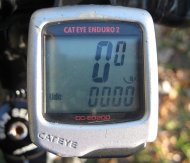
A small bicycle computer
can be a great motivator.
You’ll have to have some way of carrying all this. Inexpensive aluminum racks that install over the rear wheel are widely available. They can be fitted with a small to medium size “rack truck” type of bag (which velcros on top of the rack) or larger “pannier” bags (which clip on both sides of the rack). The pannier bags have much more volume, and are what you’ll need if you ever go bicycle touring.
One gadget you should definitely consider getting is a small “bicycle computer”. Inexpensive models sell for $20 or less, and they are great for keeping you motivated by providing quantifiable evidence that you are making progress in becoming a better cyclists. These computers have a number of functions such as: speedometer, odometer, trip-meter, average speed, time actually spent pedaling, and so on.
Cycling clothing & shoes
Regular clothes are fine for short rides when it’s not too hot out. Otherwise, you’ll find that the use of general purpose sportswear (non-cotton clothing) is a good idea, especially when cycling longer distances. Such clothes are usually made of synthetic material that is fast drying and breathable, and help keep moisture away from your body. If you really want to splurge, you can get specialized clothing such as a real cycling jersey. These have a zipper in the front and those handy pockets on the back side.
When looking at what you might wear, pay particular attention to those areas where your body will be in contact with the bike, namely your hands, rear end, and feet. A majority of people find that the padding in cycling gloves provides an extra degree of comfort and helps prevent hand numbness on longer rides.
You will also notice that cycling pants or shorts have a layer of padding (called a chamois) sewn in around the crotch and posterior areas. Again, this will provide extra comfort on longer rides. If tight Lycra shorts that are popular with some cyclists are not to your taste, you may want to look at mountain bike pants. They have a baggy outer shell, and look more like normal everyday shorts. Women may also consider getting specially made cycling skirts.
When it comes to footwear, look for light weight sport shoes with the stiffest soles that you can possibly find. Stores that specialize in outdoor recreational activities will usually carry light weight “trail running shoes”, or “approach shoes” for rock climbing. While these types of shoes have stiff soles that can make cycling more comfortable, they are still very easy to walk with. (Note: You can also consider the super rigid cycling shoes which snap onto specially made pedals, but these are generally not recommended for beginners and they are also difficult to walk with.)
A few cycling techniques to consider
The following are a few techniques that you should keep in mind as you work on improving your cycling skills.
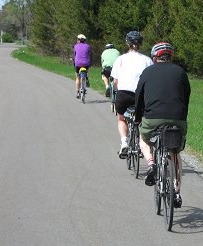
Being able to cycle in a steady straight line will come in handy
when riding with a group.
► A lot of people don’t change gears often enough and fail to make full use of the speeds on their bike. You’ll cycle far more efficiently if you get in the habit of regularly changing gears (especially the rear ones) to deal with small hills or other variations in the forward momentum of your bike. The gears on the rear wheel should shift smoothly and with little effort. If not, you probably need to make a small adjustment on your rear derailleur to compensate for cable stretch (see the maintenance tips below).
► Although they may not always notice it, many beginners tend to weave back and forth (from side to side) as they cycle in a given direction. You should try to avoid this by making a conscious effort to ride in a steady straight line. Not only will this make for more efficient biking, it is a skill that your fellow cyclists will appreciate if you ever decide to participate in group rides. Moreover, it will help keep you safe when riding on the side of busy roads.
► When it comes to safety, you should develop the proper technique for looking over your shoulder to see what’s behind you. When doing so, many cyclists inadvertently steer their bikes towards the side on which they are conducting their shoulder check. This will obviously be dangerous if you pull your bike into traffic when looking to see if there are any cars approaching from behind. Again, it is a question of practicing riding in a straight line while doing shoulder checks. Although it may sound counter intuitive, you should drop your right shoulder when turning to look over your left shoulder (and vice versa).
► For the vast majority of people it feels very natural to pedal at 60 to 70 rpm (rpm is often referred to as “cadence” in cycling) . However, you’ll ride more efficiently with a higher cadence. A good target is 80 rpm, although pro cyclists often pedal at 90 or even 100 rpm. Whatever the case, you may want to get in the habit of selecting a gear where you will be rotating your pedals slightly faster than what would feel normal. You can also get a high-end cycling computer that will provide cadence information, but these can be expensive.
► Needless to say, the bike will move forward when you apply pressure on the pedal during its downstroke. What most people don’t realize is that they leave their other foot resting on the opposite pedal during its upstroke. In other words, when apply pressure on the downstroke, they are not only moving the bike forward, they are also wasting energy lifting up the other foot. The solution is very simple: get in the habit of lifting your foot ever so slightly during the pedal’s upstroke.
► And finally, you should note that if it is being ridden on the road, a bicycle is considered a vehicle, and is subject to the same traffic laws and regulations as motorized vehicles. This includes having to go in the right direction on a one way streets, riding on the right side of the road, signaling turns and stops, coming to a stop at red lights and stops signs. These requirements are especially important when cycling through busy intersections.
A few maintenance tips
► Although it may sound obvious, keep your tires inflated to the recommended pressure range (written on the side of the tires). Heavier cyclists should use the maximum rated pressure. Tires on road bikes don’t have a lot of volume, so the loss of just a little air can make a noticeable difference. Under inflated tires will generate rolling resistance and are prone to getting more flats as a result of a pinched tube when going over a curb or hitting a potholes. Most people will find that they will have to pump up their tires at regular intervals ranging from every two or three days to once a week.
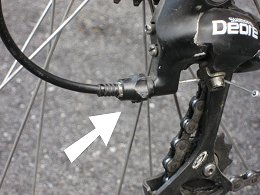
Adjustment knob on the rear derailleur. If your gears aren’t shifting smoothly, try giving it one turn (maybe two) in a counter-clockwise direction.
► If you find you are getting quite a few flats, it may be because you are riding on older tires whose rubber has dried out, or on relatively cheap tires that offer little puncture resistance. You can dramatically reduce the potential for getting a flat by riding on high quality tires which offer superior puncture protection. Such tires will also last much longer, but they can be pricey (they usually start between $30 to $40 per tire).
► If you ride often enough, your bike will eventually need a tune up because its components (brakes, derailleurs) will no longer work effectively. More often than not, there will be a need to make simple adjustments to compensate for cable stretch. You can usually accomplish this by turning the small knob on the cable’s adjusting barrels in a counter-clockwise direction. Note that the adjusting barrels can be found in different places including: on the brake levers, inline on the cable housing, where the cable attaches to the bike frame, or on brakes and derailleurs themselves. It may take several turns to adjust the brakes, but for the derailleurs, you may only want to make a half turn at a time (maybe one full turn). Count your turns so you can undo everything in case the adjustments don’t work out.
Michael McGoldrick,
August, 2009.
[feather_share]
A note of caution and disclaimer: Like many physical activities that gets you out of the house, there are certain risks associated with cycling. Moreover, you may want to consider getting a medical check up and your doctor’s okay before committing yourself to a new exercise regimen or physically demanding activity, especially if you have led a fairly sedentary lifestyle. Whatever the case, it is entirely your responsibility to decide if you are ready to take on the risks and physical activities associated with cycling.
